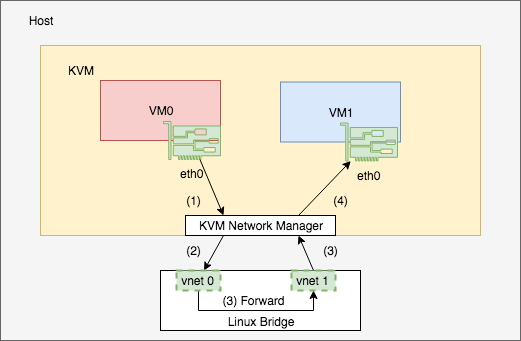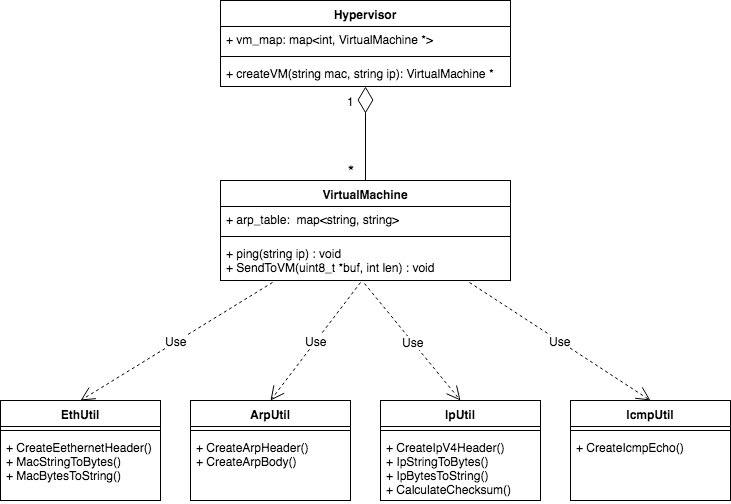Overview
We talked about TUN and TAP interface in previous post. In the article Tun/Tap interface Tutorial, the author wrote a program to demonstrate the usage of a TUN interface. In this post, we will write a program that uses TAP interfaces. The code for this lab can be found at Github.
What Will We Do?
We are going to write a hypervisor. Don’t worry. We are not going to write a real hypervisor with all functionalities. We will only simulate the network manager part. When a “virtual machine” starts, the “hypervisor” creates a TAP interface and associates it with the VM. Then the hypervisor forwards traffic between VMs and TAP interfaces. Following is a diagram from previous post.

What Will We Learn?
Through this lab, we will:
- Learn how a VM gets network access with the help of the hypervisor and TAP interface.
- Review the usage of Linux bridge.
- Practice Object-Oriented-Programming (OOP) in C++.
How Do We Implement it?
To better demonstrate the concept and make our life easy, in this lab I will omit error handling and simplify a lot of things.
Design
The two most important classes are Hypervisor class and VirtualMachine
class. Other utility classes are used to help VirtualMachine to handle network
packets.

Hypervisor
A hypervisor provides a public method to create a virtual machine. As we know, each VM has a TAP interface associated with it. These TAP interfaces are also added to a Linux bridge. To make it easy, the step of creating TAP interfaces and adding them to the bridge is done by the driver script.
VM Creation
When a VM is created, a TAP interface is also created and is added to the
bridge (This step is not in the code but in the script in this lab). Creation of
a VM may update the max_fd that is used in select() call we will see soon.
VirtualMachine *Hypervisor::createVM(const string &mac, const string &ip) {
int vm_id = next_vm_id++;
string tap_name = "tap" + to_string(vm_id);
int tap_fd = GetTapFd(tap_name);
VirtualMachine *vm = new VirtualMachine(mac, ip, tap_fd);
lock_guard<std::mutex> lock(vm_map_mutex);
vm_map[tap_fd] = vm;
max_fd = max(max_fd.load(), tap_fd);
return vm;
}
GetTapFd is used to get the file descriptor of the TAP interface. The method
will create a new TAP interface if it does not exist already. Again, in our lab,
it won’t create one because the driver script has created all TAP interfaces.
static int GetTapFd(const string &name) {
int fd, err;
if ((fd = open("/dev/net/tun", O_RDWR)) < 0) {
perror("Failed to open /dev/net/tun");
return fd;
}
struct ifreq ifr;
memset(&ifr, 0, sizeof(ifr));
// Don't provide packet information
ifr.ifr_flags = IFF_TAP | IFF_NO_PI;
if (!name.empty()) {
strncpy(ifr.ifr_name, name.c_str(), IFNAMSIZ);
}
if ( (err = ioctl(fd, TUNSETIFF, (void *) &ifr)) < 0 ) {
close(fd);
perror("Failed to create TAP interface");
return err;
}
return fd;
}
Initialization
When a hypervisor starts, it starts a thread to monitor all file descriptors of the TAP interfaces that are associated with VMs.
void Hypervisor::Init() {
max_fd = -1;
next_vm_id = 0;
auto loop = [&]() {
while (true) {
fd_set fds;
BuildFdSet(&fds);
struct timeval timeout;
timeout.tv_sec = 1;
timeout.tv_usec = 0;
int ret = select(max_fd + 1, &fds, NULL, NULL, &timeout);
if (ret < 0) {
if (errno == EINTR) {
continue;
}
perror("select()");
return;
} else if (ret == 0) {
continue;
}
HandleRead(&fds);
}
};
select_thread = thread(loop);
}
Initially the max_fd is -1, it is increased as we add more VMs. BuildFdSet
will set all existing VM’s TAP file descriptors.
void Hypervisor::BuildFdSet(fd_set *fds) {
lock_guard<std::mutex> lock(vm_map_mutex);
FD_ZERO(fds);
for (auto &kv : vm_map) {
int fd = kv.first;
FD_SET(fd, fds);
}
}
HandleRead will read from all TAP file descriptors that are ready and forward
the data to corresponding VM.
void Hypervisor::HandleRead(fd_set *fds) {
lock_guard<std::mutex> lock(vm_map_mutex);
for (auto &kv : vm_map) {
int fd = kv.first;
if (FD_ISSET(fd, fds)) {
VirtualMachine *vm = kv.second;
uint8_t buf[BUF_SIZE];
int len = read(fd, buf, sizeof(buf));
vm->SendToVm(buf, len);
}
}
}
Virtual Machine
Initialization
When the virtual machine starts, it starts a thread receiving packets from the network. It will handle the packets based on its type. Currently it only handles 4 types of packets:
- ARP Request - If the target IP address matches its own IP address, it sends an ARP reply packet to the sender.
- ARP Reply - If it receives an ARP reply packet, it means that there is a blocking outstanding ARP request. Thus it will unblock that request.
- ICMP Echo Request - Sends a ICMP echo reply packet to the sender.
- ICMP Echo Reply - If it receives an ICMP echo reply packet, it means that there is a blocking outstanding ICMP echo request. Thus it will unblock that request.
void VirtualMachine::Init() {
icmp_id = 1;
icmp_seq = 1;
// Right now we only support ingress ARP and ICMP packets
auto loop = [&]() {
cout << "VM [" << ip << ", " << mac << " starts running." << endl;
while (true) {
struct eth_hdr eth_hdr;
RecvFromNetwork((uint8_t *)ð_hdr, sizeof(eth_hdr));
string src_mac = EthUtil::MacBytesToString(eth_hdr.h_source);
cout << "[" << ip << "] Received ethernet frame from " << src_mac << endl;
eth_hdr.h_proto = ntohs(eth_hdr.h_proto);
if (ETH_P_ARP == eth_hdr.h_proto) {
HandleIngressArp();
} else if (ETH_P_IP == eth_hdr.h_proto) {
HandleIngressIcmp(src_mac);
} else {
cout << "[" << ip << "] Received unsupported ethernet type "
<< eth_hdr.h_proto << endl;
}
}
};
ingress_proc_thread = thread(loop);
}
Ping
Ping sends an ICMP echo request to destination IP. Before that, if the destination MAC address is not in the ARP table, it will first send a ARP request packet. To make it simple, after sending the ARP request and ICMP request, the thread will be blocked until the VM receives the reply.
void VirtualMachine::Ping(const string &dst_ip) {
unique_lock<mutex> arp_lock(arp_table_mutex);
if (arp_table.find(dst_ip) == arp_table.end()) {
cout << "[" << ip << "] Sending ARP request to "
<< dst_ip << "..." << endl;
SendArp(dst_ip, kEthBroadcastAddr, ARP_OP_REQUEST);
cout << "[" << ip << "] Waiting for ARP reply from "
<< dst_ip << "..." << endl;
arp_cv.wait(arp_lock, [&]{ return arp_table.find(dst_ip) != arp_table.end(); });
}
string dst_mac = arp_table[dst_ip];
uint16_t id = icmp_id++, seq_num = icmp_seq++;
pair<uint16_t, uint16_t> key = make_pair(id, seq_num);
cout << "[" << ip << "] Ping " << dst_ip << " ..." << endl;
auto start = chrono::steady_clock::now();
SendIcmp(dst_ip, dst_mac, ICMP_ECHO_REQUEST, id, seq_num);
unique_lock<mutex> icmp_lock(icmp_reply_mutex);
icmp_cv.wait(icmp_lock, [&]{ return icmp_replies.find(key) != icmp_replies.end();});
auto end = chrono::steady_clock::now();
auto diff = end - start;
cout << "[" << ip << "] Ping response from " << ip << ": icmp_seq=" << seq_num;
cout << " time=" << chrono::duration <double, milli> (diff).count() << " ms" << endl;
icmp_replies.erase(key);
}
Utility Classes
The utility classes provide helper functions to construct network packets. Since they are not the core of this lab, I won’t bother describing them one by one. You can checkout the code if interested.
How Do We Run It?
In the main function, we create a hypervisor and launch two VMs using it. Then we ping from VM1 to VM2:
int main() {
Hypervisor hypervisor;
string mac1 = "00:00:00:00:00:01";
string ip1 = "192.168.1.1";
VirtualMachine *vm1 = hypervisor.createVM(mac1, ip1);
string mac2 = "00:00:00:00:00:02";
string ip2 = "192.168.1.2";
VirtualMachine *vm2 = hypervisor.createVM(mac2, ip2);
// Wait for the VM to start
this_thread::sleep_for (std::chrono::seconds(1));
// Ping VM2 from VM1
vm1->Ping(ip2);
//vm2->Ping(ip1);
this_thread::sleep_for (std::chrono::seconds(300));
return 0;
}
Before running it, we need to do some preparation.
$ sudo brctl addbr br0 # Add bridge br0
$ sudo ip tuntap add dev tap0 mode tap # Add TAP interface tap0
$ sudo ip tuntap add dev tap1 mode tap # Add TAP interface tap1
$ sudo brctl addif br0 tap0 # Add tap0 to br0
$ sudo brctl addif br0 tap1 # Add tap1 to br0
$ sudo ifconfig tap0 up
$ sudo ifconfig tap1 up
$ sudo ifconfig br0 up
And we can start wireshark to capture the packets on tap0.
Now compile the code and run.
$ make
$ ./tap-lab
VM [192.168.1.1, 00:00:00:00:00:01] starts running.
VM [192.168.1.2, 00:00:00:00:00:02] starts running.
[192.168.1.1] Sending ARP request to 192.168.1.2...
[192.168.1.1] Waiting for ARP reply from 192.168.1.2...
[192.168.1.2] Received ethernet frame from 00:00:00:00:00:01
[192.168.1.2] Received ARP request: [Who has 192.168.1.2? Tell 192.168.1.1]
[192.168.1.2] Sending ARP reply: [192.168.1.2 is at 00:00:00:00:00:02]
[192.168.1.1] Received ethernet frame from 00:00:00:00:00:02
[192.168.1.1] Ping 192.168.1.2 ...
[192.168.1.2] Received ethernet frame from 00:00:00:00:00:01
[192.168.1.2] Received ICMP request id = 1, seq_num = 1
[192.168.1.2] Sending ICMP reply id = 1, seq_num = 1
[192.168.1.1] Received ethernet frame from 00:00:00:00:00:02
[192.168.1.1] Received ICMP reply id = 1, seq_num = 1
[192.168.1.1] Ping response from 192.168.1.1: icmp_seq=1 time=1.78907 ms
In wireshark, we get

This is a very typical ping traffic. And this traffic shows that we successfully simulate the behavior of hypervisor and VMs with the help of TAP interface and Linux bridge.
Next Steps
Readers are encouraged to extend this lab to support more packet type and make the hypervisor and VM more robust. The code can be found at Github
Reference
[1] tuntap
[2] Tun/Tap interface
tutorial
